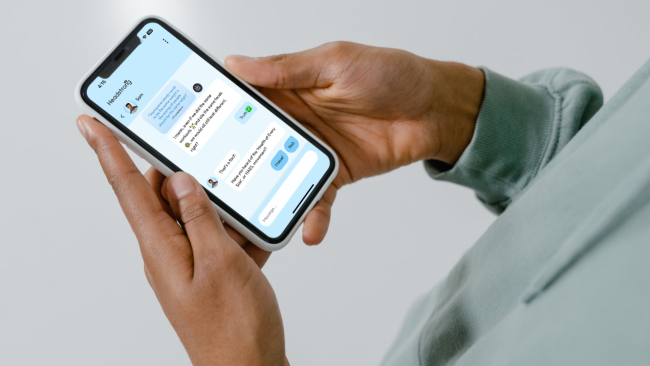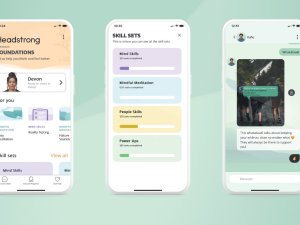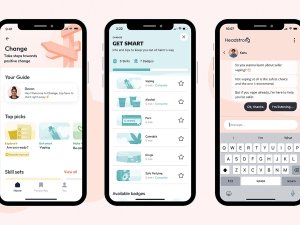Respiratory physician Lutz Beckert considers chronic obstructive pulmonary disease management, including the prevention of COPD, the importance of smoking cessation and pulmonary rehabilitation, and the lifesaving potential of addressing treatable traits. He also discusses the logic of inhaler therapy, moving from single therapy to dual and triple therapy when indicated, as well as other aspects of management
Active bodies, resilient minds: Building mental health in young people
Active bodies, resilient minds: Building mental health in young people

This article highlights recent updates to the Headstrong app and explores the benefits of physical activity for mental wellbeing. It includes some tips on talking with young people about physical activity goals
-
The new “Move” collection in the Headstrong app focuses on how physical activity enhances both mental and physical wellbeing and addresses common barriers to physical activity for young people.
-
GPs, nurses and health improvement practitioners can help young people set realistic physical activity goals and support them to use Headstrong.
This Practice article has been endorsed by the RNZCGP and has been approved for up to 0.5 credits for continuing professional development purposes (2 credits per learning hour). To claim your CPD credits, log in to your Te Whanake dashboard and record this activity under the appropriate learning category.
Nurses may also find that reading this article and reflecting on their learning can count as a professional development activity with the Nursing Council of New Zealand (up to 0.25 PD hours).
Since its launch in 2022, Headstrong, a free app funded by Te Whatu Ora, has supported the mental health and wellbeing of young New Zealanders. Initially designed as a preventive mental health tool, Headstrong has grown to address young people’s broader needs.
Though Headstrong was developed with high-school-aged teens in mind, its content is relevant to a wider audience, including intermediate students and young adults. The app’s modules are grounded in evidence-based strategies that help young people build resilience and manage emotions. Drawing on cognitive behavioural therapy, interpersonal therapy, positive psychology, mindfulness, Te Whare Tapa Whā and harm minimisation, Headstrong adapts these approaches to help users navigate life’s challenges.
Content is delivered through a rule-based chatbot, which creates an interactive, conversation-style experience. Users follow branching paths based on their responses, which provides a personalised journey through each module. Short, bite-sized activities and an intuitive interface make it easy for users to engage without feeling overwhelmed. Behind the scenes, a content management system enables Headstrong’s team to collaborate with mental health experts to keep the app relevant and effective.
Teenage years are often associated with high energy, sports and constant movement, but this isn’t the case for everyone. Adolescence is also a period when lifelong habits begin to take shape, and a combination of factors – lack of motivation, busy academic schedules, low self-esteem and peer pressure – can cause many young people to drift away from activities they once enjoyed. As teens gain independence, parents naturally have less influence, and physical activity may feel more like a chore than an enjoyable activity.
Physical movement, however, can be an effective way to support mental health. When young people engage in physical activity – whether through exercise, walking, dancing or any form of movement – their brains release endorphins and serotonin, which can help lift mood and reduce stress. Movement also improves focus, supports healthy sleep and builds resilience against life’s pressures.
Encouraging young people to reconnect with enjoyable, accessible activities, such as dancing, kapa haka, skateboarding or exploring nature, can support mental health in a way that feels natural and sustainable.
In collaboration with Sarah Hopkins from the University of Auckland, Headstrong introduced the Move collection, focusing on how physical activity enhances both mental and physical wellbeing. Unlike many tracking or fitness apps, Move does not monitor metrics or track exercise progress. Instead, it offers simple, accessible insights into the mental health benefits of physical activity, making it an ideal resource for those who are unsure about how to get started or maintain a healthy habit.
The Move collection is designed to appeal to both active teens and those who may feel hesitant about physical activity. Modules within Move cover practical goal setting, small achievable steps, and ways to manage obstacles, such as body image concerns, lack of resources and low motivation. Through Move, users learn to set realistic goals, manage setbacks and build a healthier relationship with physical activity. The aim is to demystify the relationship between physical and mental health, making movement accessible for everyone.
For healthcare providers interested in Headstrong, here is a small sample of skill modules related to physical activity and wellbeing in the Move collection:
- Health at every size – explores body image topics and emphasises that health looks different for everyone.
- Perseverance – teaches mental toughness, competence and confidence.
- Performance – offers tips on nutrition, sleep and motivation, with guidance on using journaling for goal setting.
- Sleep – debunks common myths and provides sleep hygiene tips.
- Exercise and wellbeing – explores the relationship between exercise and mental health through Te Whare Tapa Whā.
Feedback consistently highlights the demand for body image content, with these modules among the most accessed on Headstrong. Today’s young people are frequently exposed to unrealistic beauty standards on social media, which can impact their self-esteem and mental health. Headstrong’s body image module offers strategies for navigating these pressures, fostering healthier self-image and confidence.
GPs, practice nurses and health improvement practitioners can have conversations about physical activity with young people, to encourage healthier lifestyles and support mental health. Here are some practical ways to guide young people in setting physical activity goals:
Make it relevant – emphasise that any form of regular movement counts. Physical activity doesn’t need to mean going to the gym; it can include youth-friendly activities such as dancing, skateboarding, kapa-haka or bushwalking. Young people often respond better to activities that feel accessible and enjoyable rather than strictly performance focused.
Encourage whānau involvement – physical activity can be even more rewarding when shared with family/whānau. Encourage young people to set shared goals with their family, such as regular walks, playing a sport together or trying new activities on weekends. Young people can even take the lead in motivating their parents or siblings, creating a supportive environment where everyone benefits.
Provide psychoeducation on the brain–body connection – many young people are interested in understanding the brain–body connection and are open to learning how physical activity benefits mental health. Using simple neuropsychological concepts, explain how movement releases “feel-good” chemicals such as endorphins and serotonin, which boost mood, reduce stress and promote better sleep. This approach fosters curiosity rather than resistance, helping young people understand the mental health impact of exercise.
Set realistic goals – encourage young people to start small. Setting achievable goals, such as walking a certain number of steps each day or trying a new activity once a week, can help build confidence and a sense of accomplishment. Gradually increasing the frequency or intensity of physical activity helps prevent burnout and creates a positive habit.
Frame exercise as stress management – physical activity is a powerful tool for managing stress. Explain how regular movement can help reduce anxiety, improve mood and aid sleep. For young people facing academic or social pressures, exercise offers a way to clear their minds and refocus. Physical activity also encourages a form of mindfulness as focusing on one activity at a time – whether it’s running, dancing or skateboarding – can help take the mind off stressors and promote a sense of calm.
Address common barriers – many young people face obstacles to staying active, whether it is body image concerns, lack of motivation or muscle soreness after a new activity. Acknowledge these barriers and offer strategies to overcome them, such as exploring non-competitive, low-intensity forms of exercise.
Encourage self-reflection and progress tracking – physical activity can also be used for self-reflection. Encourage young people to track their feelings before and after exercising, which can help them recognise the positive impact of movement on their mood and energy levels.
In addition to clinical conversations, digital tools such as Headstrong offer practical, accessible support for young people working to build and maintain healthy lifestyles. For young people seeking self-directed help, Headstrong provides a toolkit of interactive, youth-friendly resources that promote resilience. Clinicians can recommend Headstrong as a resource that complements their work, teaching young people strategies for self-care, stress management and holistic health.
As Headstrong evolves, new content based on young people’s feedback will continue to expand the app’s offerings. This ongoing development keeps Headstrong relevant and responsive to the needs of today’s youth. We encourage health professionals to explore Headstrong, share it with young people, and stay tuned for more new content to support wellbeing and resilience.
For more information or to explore Headstrong’s offerings (over 100 skills and strategies), visit the website (headstrong.org.nz) or download the app from the App Store or Google Play. Headstrong is also available as a web platform, allowing users to access resources without downloading the app.
Additionally, visit headstrong.org.nz/physical-resources to order informative materials, including posters and referral cards, which can be shared with young people and others interested in learning more about Headstrong.
Karolina Stasiak is a senior lecturer at the Department of Psychological Medicine, University of Auckland, and leads the Headstrong national implementation project
You can use the Capture button below to record your time spent reading and your answers to the following learning reflection questions, which align with Te Whanake reflection requirements (answer three or more):
- What were the key learnings from this activity?
- How does what you learnt benefit you, or why do you appreciate the learning?
- If you apply your learning, what are the benefits or implications for others?
- Think of a situation where you could apply this learning. What would you do differently now?
- If an opportunity to apply this learning comes up in the future, what measures can be taken to ensure the learning is applied?
- Can you think of any different ways you could apply this learning?
- Are there any skills you need to develop to apply this learning effectively?
We're publishing this article as a FREE READ so it is FREE to read and EASY to share more widely. Please support us and our primary care education resources – subscribe here









![Barbara Fountain, editor of New Zealand Doctor Rata Aotearoa, and Paul Hutchison, GP and senior medical clinician at Tāmaki Health [Image: Simon Maude]](/sites/default/files/styles/thumbnail_cropped_100/public/2025-03/Barbara%20Fountain%2C%20editor%20of%20New%20Zealand%20Doctor%20Rata%20Aotearoa%2C%20and%20Paul%20Hutchison%2C%20GP%20and%20senior%20medical%20clinician%20at%20T%C4%81maki%20Health%20CR%20Simon%20Maude.jpg?itok=-HbQ1EYA)
![Lori Peters, NP and advanced health improvement practitioner at Mahitahi Hauora, and Jasper Nacilla, NP at The Terrace Medical Centre in Wellington [Image: Simon Maude]](/sites/default/files/styles/thumbnail_cropped_100/public/2025-03/2.%20Lori%20Peters%2C%20NP%20and%20advanced%20HIP%20at%20Mahitahi%20Hauora%2C%20and%20Jasper%20Nacilla%2C%20NP%20at%20The%20Terrace%20Medical%20Centre%20in%20Wellington%20CR%20Simon%20Maude.jpg?itok=sUfbsSF1)
![Ministry of Social Development health and disability coordinator Liz Williams, regional health advisors Mary Mojel and Larah Takarangi, and health and disability coordinators Rebecca Staunton and Myint Than Htut [Image: Simon Maude]](/sites/default/files/styles/thumbnail_cropped_100/public/2025-03/3.%20Ministry%20of%20Social%20Development%27s%20Liz%20Williams%2C%20Mary%20Mojel%2C%20Larah%20Takarangi%2C%20Rebecca%20Staunton%20and%20Myint%20Than%20Htut%20CR%20Simon%20Maude.jpg?itok=9ceOujzC)
![Locum GP Helen Fisher, with Te Kuiti Medical Centre NP Bridget Woodney [Image: Simon Maude]](/sites/default/files/styles/thumbnail_cropped_100/public/2025-03/4.%20Locum%20GP%20Helen%20Fisher%2C%20with%20Te%20Kuiti%20Medical%20Centre%20NP%20Bridget%20Woodney%20CR%20Simon%20Maude.jpg?itok=TJeODetm)
![Ruby Faulkner, GPEP2, with David Small, GPEP3 from The Doctors Greenmeadows in Napier [Image: Simon Maude]](/sites/default/files/styles/thumbnail_cropped_100/public/2025-03/5.%20Ruby%20Faulkner%2C%20GPEP2%2C%20with%20David%20Small%2C%20GPEP3%20from%20The%20Doctors%20Greenmeadows%20in%20Napier%20CR%20Simon%20Maude.jpg?itok=B0u4wsIs)
![Rochelle Langton and Libby Thomas, marketing advisors at the Medical Protection Society [Image: Simon Maude]](/sites/default/files/styles/thumbnail_cropped_100/public/2025-03/6.%20Rochelle%20Langton%20and%20Libby%20Thomas%2C%20marketing%20advisors%20at%20the%20Medical%20Protection%20Society%20CR%20Simon%20Maude.jpg?itok=r52_Cf74)
![Specialist GP Lucy Gibberd, medical advisor at MPS, and Zara Bolam, urgent-care specialist at The Nest Health Centre in Inglewood [Image: Simon Maude]](/sites/default/files/styles/thumbnail_cropped_100/public/2025-03/7.%20Specialist%20GP%20Lucy%20Gibberd%2C%20medical%20advisor%20at%20MPS%2C%20and%20Zara%20Bolam%2C%20urgent-care%20specialist%20at%20The%20Nest%20Health%20Centre%20in%20Inglewood%20CR%20Simon%20Maude.jpg?itok=z8eVoBU3)
![Olivia Blackmore and Trudee Sharp, NPs at Gore Health Centre, and Gaylene Hastie, NP at Queenstown Medical Centre [Image: Simon Maude]](/sites/default/files/styles/thumbnail_cropped_100/public/2025-03/8.%20Olivia%20Blackmore%20and%20Trudee%20Sharp%2C%20NPs%20at%20Gore%20Health%20Centre%2C%20and%20Gaylene%20Hastie%2C%20NP%20at%20Queenstown%20Medical%20Centre%20CR%20Simon%20Maude.jpg?itok=Z6u9d0XH)
![Mary Toloa, specialist GP at Porirua and Union Community Health Service in Wellington, Mara Coler, clinical pharmacist at Tū Ora Compass Health, and Bhavna Mistry, specialist GP at Porirua and Union Community Health Service [Image: Simon Maude]](/sites/default/files/styles/thumbnail_cropped_100/public/2025-03/9.%20Mary%20Toloa%2C%20Porirua%20and%20Union%20Community%20Health%20Service%20in%20Wellington%2C%20Mara%20Coler%2C%20T%C5%AB%20Ora%20Compass%20Health%2C%20and%20Bhavna%20Mistry%2C%20PUCHS%20CR%20Simon%20Maude.jpg?itok=kpChr0cc)